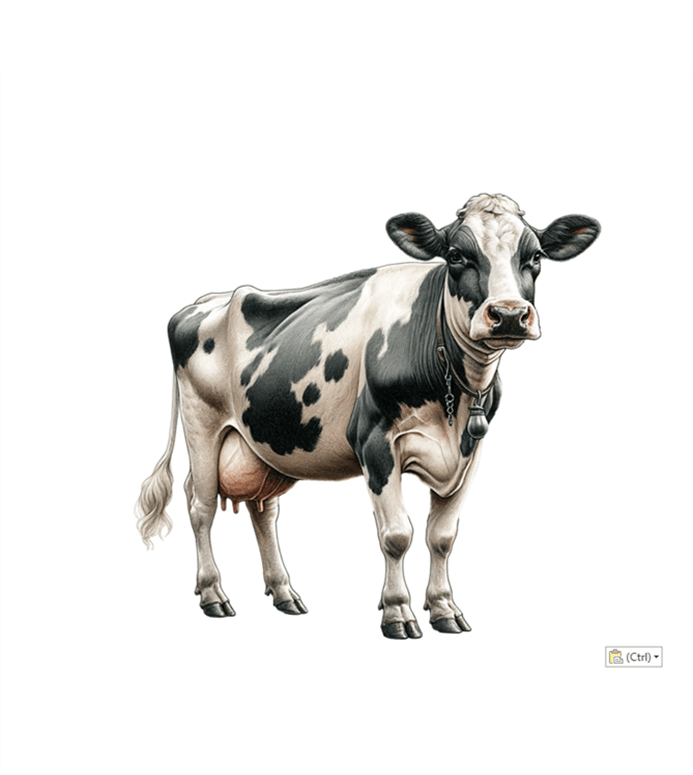Research Update: Performance of Dairy Heifers on Pasture Relative to TMR-fed Counterparts
Amanda Grev PhD, Forage and Pasture Specialist, University of Maryland Extension
Jeff Semler, Principal Agent, University of Maryland Extension
Over the past several years, a study was completed at the Central Maryland Research and Education Center Clarksville Dairy farm to investigate the effects of improved grazing management on pregnant dairy heifer performance. The objectives were to determine the effect of improved grazing management on heifer growth characteristics, as well as the economic feasibility of using a rotational grazing system to mitigate costs associated with the replacement program. Heifers are also being followed through their first lactation to investigate potential carry-over effects on first lactation performance.
Methods
Pregnant Holstein dairy heifers (n=166; 2021-2023) from the University of Maryland Dairy were utilized for this study. Heifers were enrolled in the study on a rolling basis, with heifers added following pregnancy confirmation and removed approximately 3 weeks prior to calving. Upon enrollment, heifers were randomly assigned to one of two treatments groups: control (CON) or grazing (ROT). Heifer groups varied in size throughout the study period (ranging from 15 to 22 per group) but were kept consistent between treatments at any given time.
Heifers in the CON group received a total mixed ration (TMR) once per day and had access to one continuously managed 6-acre perennial pasture consisting of mostly endophyte-infected tall fescue. Heifers in the ROT group were rotationally grazed across 21 acres of both perennial and annual pastures subdivided into approximately 0.6-acre paddocks; heifers were rotated to a new paddock every 1-3 days, depending on forage availability. Perennial pastures within the rotational grazing system were similar to the control pasture and consisted of mostly endophyte-infected tall fescue. Annual pastures within the rotational grazing system were established on a seasonal, rotating basis using cool-season annuals (triticale/oat/annual ryegrass/crimson clover mixture) followed by warm-season annuals (sudangrass/cowpea mixture). Heifers in the ROT group also received a daily ground corn/mineral mix at a rate of 1 pound per head per day to ensure appropriate mineral intake. An overview of the pasture layout and sizing for both groups is depicted in Fig. 1.
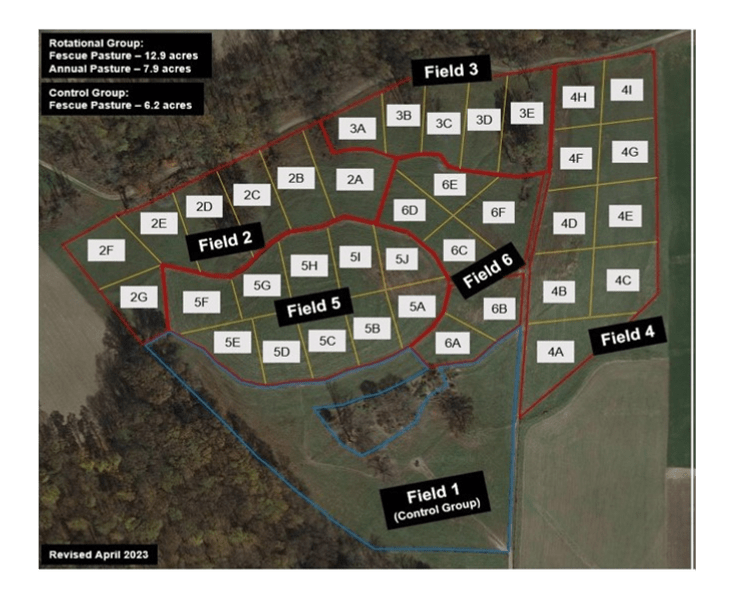
The study ran annually from around the beginning of April through the end of December. Throughout the growing season, heifers in the ROT group alternated between annual and perennial pastures based on forage availability and growth; actual dates spent grazing the different forage types varied from year to year, but as an example the grazing dates for 2021 are shown in Figure 2. Throughout the study, both groups of heifers were measured every two weeks to determine bodyweight, body condition score, and hip height. Forage samples were collected every two weeks to determine forage nutritive value; for each treatment group, samples were collected from the paddock immediately prior to grazing.
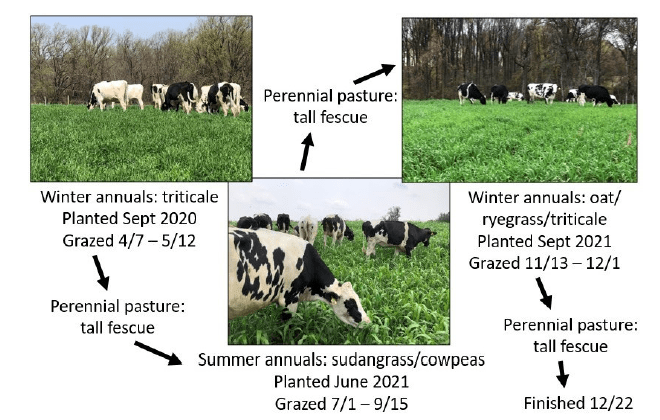
Results
Analysis of the results for this study are in progress, but some preliminary results from the first grazing season (2021) are presented here. On average, heifers were enrolled in the study for 140 days. The average nutrient composition of the TMR fed to the CON heifers and the pastures grazed by both CON and ROT heifers are shown in Table 1.

Initial bodyweight, body condition score, and hip height were similar between treatment groups (Figure 3). Final bodyweight and hip height were also similar between the two groups, but final body condition score was greater for CON heifers (3.7) compared to ROT heifers (3.5; Figure 3B). Although final bodyweight was not statistically different between treatment groups, average daily gain was greater for CON heifers (1.9 lb/d) compared to ROT heifers (1.5 lb/d) over the 2021 grazing season.
Implications of the slightly lower body condition of ROT heifers is unknown, but we hypothesize that there may be a positive effect on first lactation performance since heifer body condition was still good and it is well-established that cows that calve with higher body condition are predisposed to metabolic problems (e.g., ketosis, fatty liver, etc.). Performance of heifers from both treatment groups are being tracked as heifers go through their first lactation; additional data analysis will explore possible carry-over effects of these management systems on first lactation milk production, health, and reproductive performance once all heifers have calved.
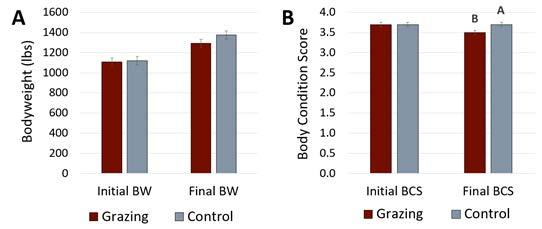
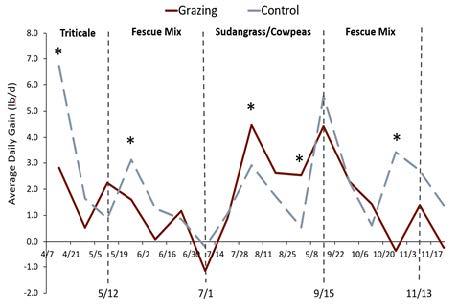
Interestingly, heifers in both groups lost weight following their enrollment in the study, suggesting that both groups required an adaptation period to adjust to their new environment. Prior to study enrollment, all heifers were group-housed in a barn and fed a TMR once daily. Following study enrollment, CON heifers required an average of 23 days to regain their starting bodyweight while ROT heifers required an average of 35 days. The longer adaptation period for the ROT heifers is not surprising given that they experienced a more dramatic change in housing and diet compared to the CON heifers.
Heifer average daily gains varied considerably across weigh periods; this variability in daily bodyweight gains for both groups of heifers is demonstrated in Figure 4. Variability in daily gains was likely due to a number of factors, including heifer adaptation, heifers entering/leaving the study, changes in forage type and forage quality over time (especially for the ROT group), and varying weather conditions throughout the grazing season. The ROT heifers appeared to perform substantially better while grazing the warm-season annual mixture (sudangrass/cowpea) during the heat of the summer, which might be expected given the nutrient profile of this pasture (shown in Table 1).
Take Home & Conclusions
A detailed economic analysis comparing expenses between these systems is forthcoming. Although these preliminary results indicate a slower growth rate for ROT heifers, final body weights and body condition scores of these heifers were still acceptable and they achieved or exceeded 85% of mature bodyweight at first calving. Because the replacement heifer program is typically the second or third greatest expense on the dairy and feed often exceeds 50% of those costs, increasing utilization of pasture may be an economical choice for some producers to reduce costs on their farm without compromising performance.
Producers looking to improve grazing systems on their farm should begin by exploring simple management changes including the implementation (or increased intensity) of rotational grazing practices. Incorporation of annual forages into the grazing system may also help improve animal performance by offsetting the reduced summer growth (i.e. summer slump) in perennial pastures and mitigating the palatability and forage intake issues associated with endophyte-infected tall fescue pastures during the summer.
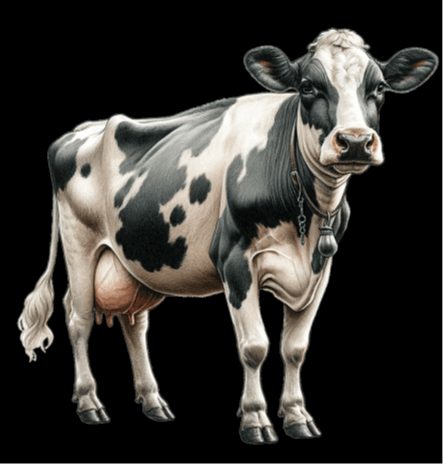
Future Plans
Moving forward, a full analysis of all three years of this study will be completed, along with a comprehensive analysis comparing the economics behind
heifer performance within each of these systems. Future studies will continue to explore how improvements in pasture management affect heifer performance and the economic viability of the heifer program.
Acknowledgements
We are grateful for the assistance provided by the staff at the Clarksville Dairy Farm in support of this study. This study was partially funded by the Maryland Agricultural Experiment Station Competitive Grants Program and by a Northeast SARE Research and Education Grant.
__________________________________________________________________________________________________________
